12-24 March 2014.
From Don’s Journal: Wednesday March 12, 2014. So finally we’ve arrived in Cuenca, a place to stop and recuperate from the intensity of our Amazonia adventure and our Galapagos cruise. Time to slow down and stop all the doing for a while. Time to stroll around the streets of Cuenca and enjoy the sights of this beautiful city. Time to get sane again, and to get healthy again.
**********************
The Cuenca area has been inhabited since 8000 BC. A settlement by the Cañari people, dating back to 500 BC, was known as Guapondeleg, meaning ‘land as big as heaven’. I can imagine the early nomads in their soft hide clothing, carrying spears and herding llama, choosing this place: a beautiful expansive valley surrounded by mountains, and lush with the plentiful water of four rivers flowing through it. Land as big as heaven indeed.
Less than fifty years before the Spanish invasion, the Inca, after a protracted struggle, conquered the Cañari and changed the town’s name first to Tomebamba then to Pumapungo, and developed it into a regional capital that rivaled the Inca capital of Cusco in its magnificence. Spanish occupation came in the late 1500’s and the name was changed again, to Cuenca, after the city in Spain.
If you google Cuenca, Ecuador you will find more than half of the first page devoted to links dealing with real estate and expat retirement. Cuenca offers low cost living, good health care, natural beauty, a mild climate, and loads of cultural opportunities. Approximately five to ten thousand US and Canadian expats live there along with about half a million Ecuadorians.
We arrived in Cuenca after three weeks exploring Buenos Aires, three weeks dashing like mad things all over Patagonia, two weeks travelling by bus through the Atacama desert in Chile, a three-day overland trip across the high Andes in Bolivia, three weeks exploring the Cusco-Machu Picchu area, a week in Lima, nine days exploring the Amazon jungle, nearly two weeks attending a major dance and music festival in Puno, Peru, a week in Quito, and just over a week snorkeling and hiking in the Galapagos. This six-month jaunt involved eight major altitude changes, up and down, resulting in low energy and lack of stamina every time we went up again. We were exhausted. We didn’t really know just how exhausted we were – that came later in Cyprus when it all caught up with us – but we did know we didn’t want to go out and explore all that much. We settled into our apartment and found our way to the local markets and grocery stores.
Slowly we ventured out and began exploring the Spanish colonial core of the town: elegant buildings from a bygone era, riverside pathways, and open squares with graceful gardens. It is, justifiably, a UNESCO World Heritage site.
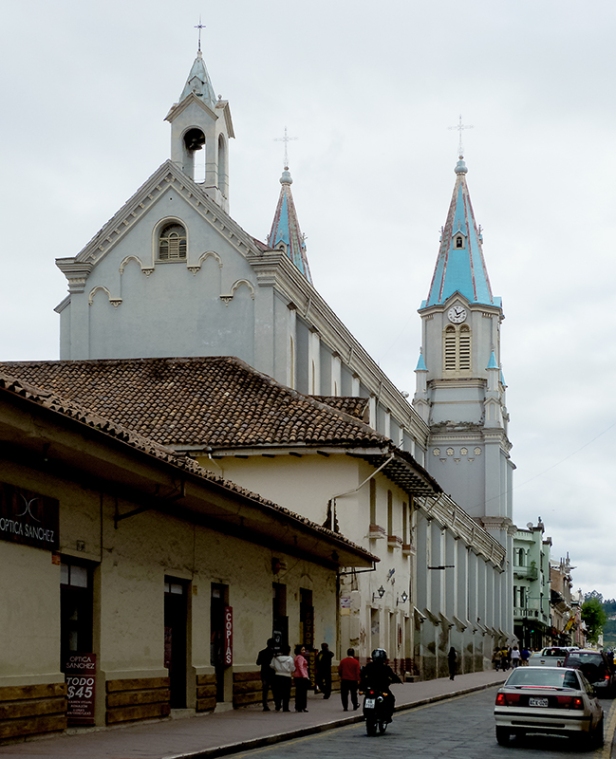
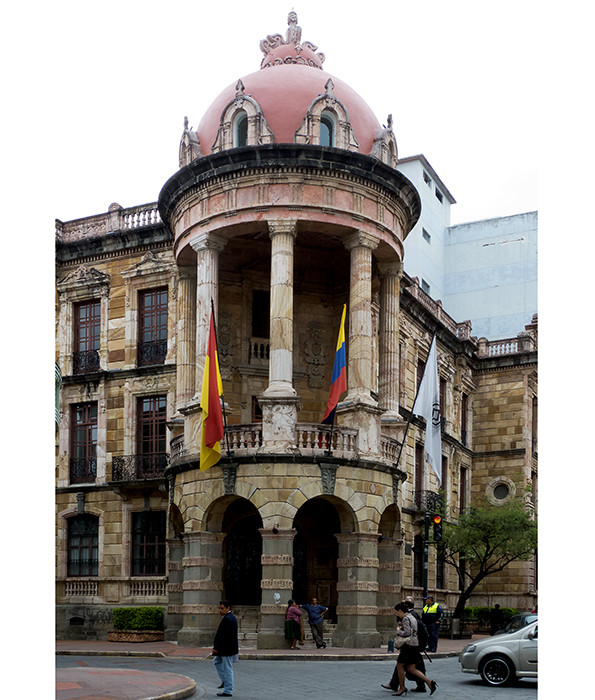



One day we walked some way out of the central core, across the Pan American Highway, and up the stairs, all 440 of them, to see the view of Cuenca from the village of Turi,
and on another day we visited the beautiful Cathedral of the Immaculate Conception, the hallmark symbol of the city with its unique blue and white tiled domes.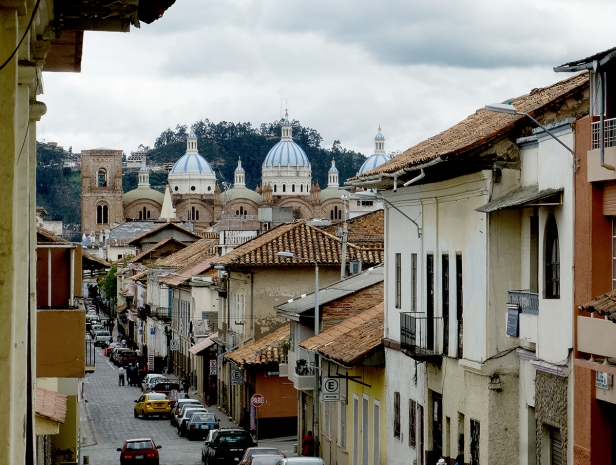

We visited the Museo Banco Central with its fabulous life-size dioramas of traditional village life and its collection of shrunken heads, and then continued on into the gardens, and the ruins of the Inca city of Pumapungo. We did not find the ruins in any way remarkable, but then we’d been spoilt by having visited the best of the Inca ruins in and around Cusco and at Machu Picchu.
There’s an aviary in the gardens next to Pumapungo with many exotic birds, and a pond that’s home to some geese with faces only a mother could love.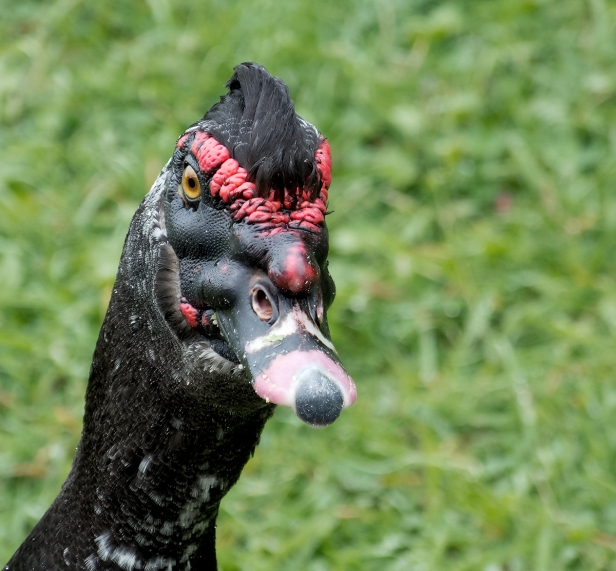

Walking home from the gardens we happened upon some traditional dancing in the square near our favourite supermarket. Of course we happened upon traditional dancing; I think we draw it to us like a magnet wherever we go. And the peoples of South America, especially the peoples of the Andes, have a rich and abundant tradition of music and dancing that has survived and thrived through hundreds of years. Any excuse will do for a festival, any excuse for dressing up and dancing. I have no idea of the purpose of this particular celebration but I’m glad I got to see it.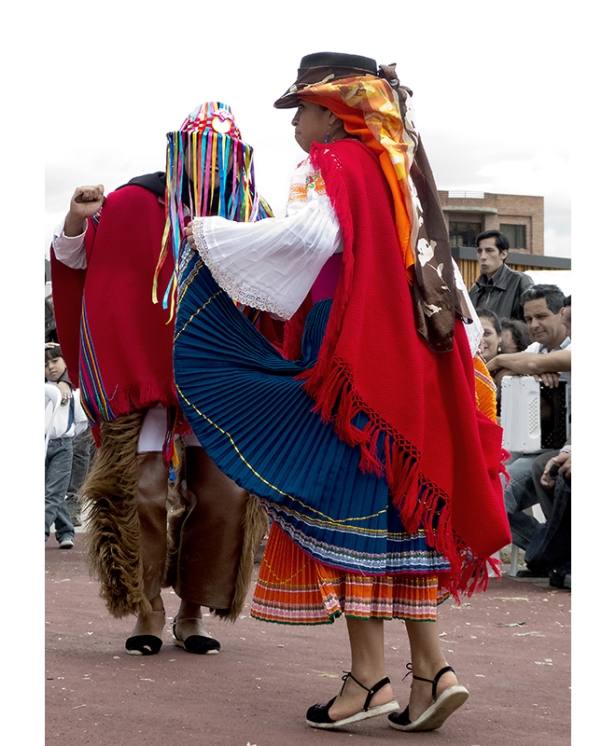
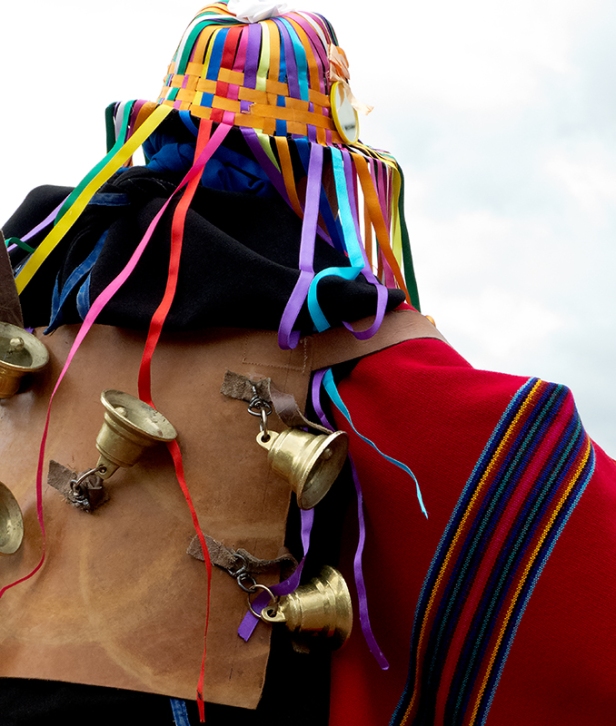
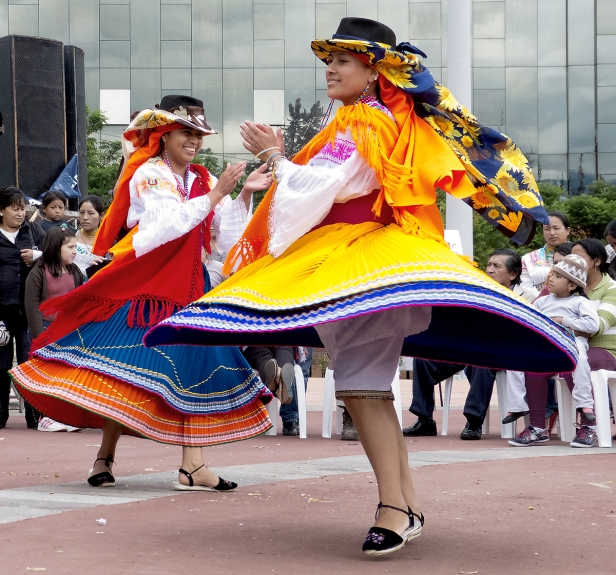
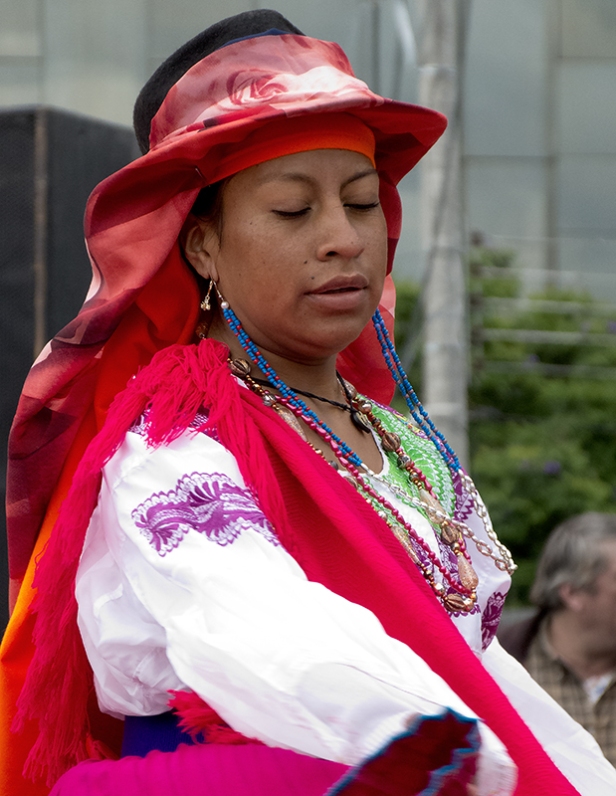
Wandering all through the town, in various places, we discovered some fabulous street art (what’s the meaning of it all?),
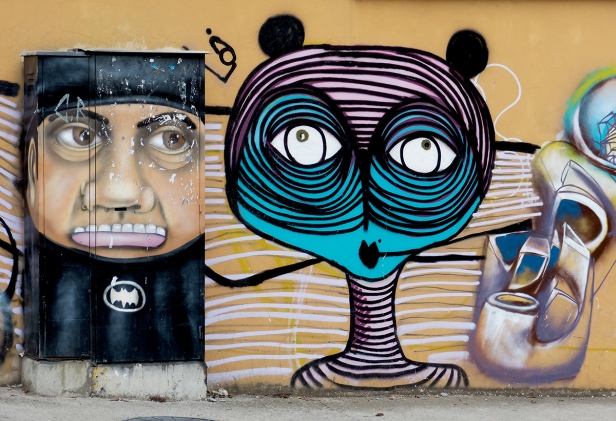

a huge flock of pigeons in one of the squares,
and a unique shop dummy.
My sister Julie got me looking at shop dummies. She has been photographing them all over the world putting together a portfolio showing the insidious dominance of the fashion industry’s ideal of female beauty – always and only tall, thin, blond, blue-eyed and Caucasian, no matter the country. Andean (and Indian) women could not be further from this ‘ideal’ and yet I saw blond, blue-eyed shop dummies in both South America and India. Don’t they make black-haired brown-skinned shop dummies? Probably not.
The local market, spilling out onto the street.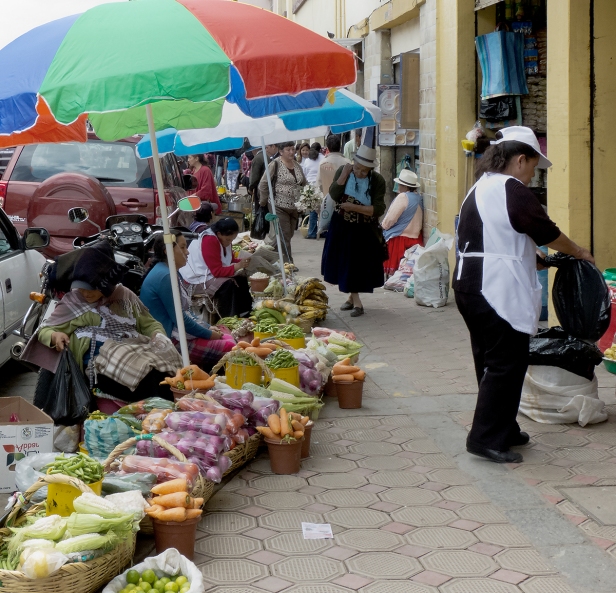
On a bright shining sunny day, the heat intense, the sun relentless, she was sitting all morning selling vegetables and she forgot her hat. No matter. A lettuce leaf serves just as well.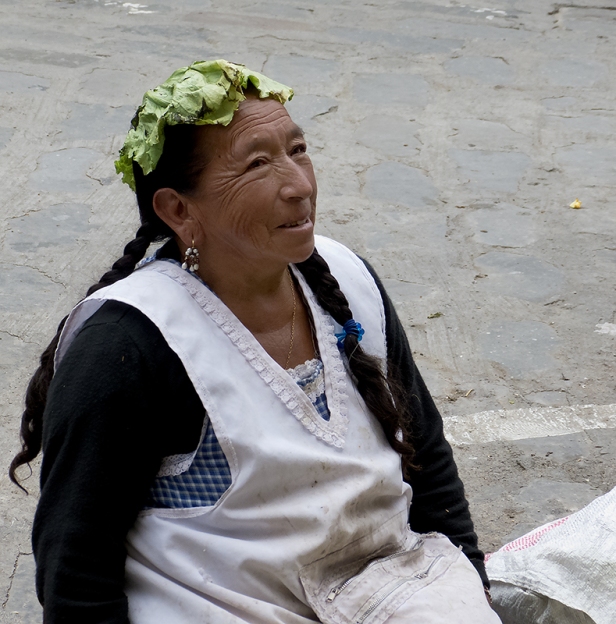
Roaming fruit vendors

Although we explored the town, and did a couple of day trips out of town, Cuenca was very much a rest stop for us. We’d been travelling hard for six months and neither of us had much energy left. Plus we’d been flung, once again, from sea level in the Galapagos to 2500 metres in Cuenca, so were feeling the altitude. It was our last stop in South America and we were pretty much travelled out. Gentle Cuenca was the perfect place to be.
Next post: The Inca ruins of Inga Pirca, and the Cañari market.
All words and images by Alison Louise Armstrong unless otherwise noted
© Alison Louise Armstrong and Adventures in Wonderland – a pilgrimage of the heart, 2010-2015.

Wonderful to gain an insight into this Ecuadorian city; and to be treated to such rich accompanying imagery including the wonderful street art.
Very many thanks!
Hariod Brawn.
LikeLike
Thank you so much Hariod. We found Cuenca to be quite delightful, and just what we needed.
Alison
LikeLike
sigh.. cuenca is truly an elegant and well-dressed lady, and you did a lovely job of capturing her essence! makes me wistful to visit, though it’s hard to reach cuenca from my perch on the pacific coast.
on my next trip there, i plan to visit ingapirca again, so i look forward to your post.. last time there i walked along the back edge and later peered at my photos and thought, ‘was i under some kind of magical spell? ” i can’t believe i walked that without one qualm of falling!
thanks so much for sharing your cuenca experience!
lisa/z
LikeLike
Thanks Lisa. I love your description of Cuenca. We really enjoyed our time there even though we were pooped and didn’t do much.
Alison
LikeLike
What a wonderful post. The photos are terrific, really love them. ❤
LikeLike
Thanks so much Paulette. Glad you enjoyed it.
Alison
LikeLike
Years ago, when I was studying in Switzerland, I decided to go to Madrid for a few days in late November. It was the only trip I took that semester without an agenda – nothing in specific I wanted to see or do. And you know, those warm days wandering the streets of Madrid were – and remain – just as satisfying in their own way as the other, more touristy trips I took that semester.
Cuenca sounds like it was that kind of place for you, and I’m glad of it. One can only be on the go for so long before you need time to relax and let it all sink in. Except for the odd street dance or two, of course. 🙂
LikeLike
Yes, Cuenca was that kind of place for us – wandering out and about when we felt like it, staying home when we didn’t. It was very restful. Glad we got to see the dancing though 🙂
LikeLike
There is so much beauty in this world. Thank you for being my eyes.
LikeLike
You’re welcome Kelly. Cuenca certainly is a lovely town.
LikeLike
Total appreciation for your need to stop after such a challenging itinerary. For myself, I kinda hate to say goodbye to the magical Galapagos. Have you ever considered posting a group of the many Galapagos photos that didn’t make the cut for the blog somewhere on the site? I’d love to meander through them.
LikeLike
Yeah, we really needed to stop. We followed 12 days in Cuenca by stopping for 2 months in Cyprus. Finally feel like we’re recovering.
I will maybe do another Galapagos post in the next few months – just pictures. You’re right – there are many that didn’t make the cut but are still good photos. Another post is a good idea. Not yet. Even to just prepare them for uploading will take quite a bit of time.
LikeLike
I am unable to travel but feel like I am when I read about your adventures. Thank you.
LikeLike
Thank you so much. That’s a wonderful compliment.
Alison
LikeLiked by 1 person
I understand the difficulty of preparing photo galleries and the time involved, so I know what I have suggested re: a Galapagos photo project. The hubby uses Cincopa for his galleries, which are groups of photos with descriptions but not commentary. Even without an accompanying blog post, he spends endless hours sitting in front of the computer, arranging. Well, no hurry. There’s time to rest, time to travel, and [much] time later for projects.
LikeLike
I have some good news for you. We met Kenny on the Galapagos cruise. He has sent us quite a few of his glorious photos. I’ll do another Galapagos post of his photos very soon. No writing probably, just his superb pics. You’ll love them.
LikeLike
Wonderful!
LikeLike
Thanks Dani ❤
LikeLike
Simply stunning photographs…you make me YEARN for travel…thanks for this 🙂
LikeLike
Thank you so much, and you’re welcome. Your time will come 🙂
Alison
LikeLike
Cuenca and this post just have the feel of relaxation. Some street art to keep it interesting. And a duck whose genetic outcomes make you want to stare up its nose rather than look it in the eye. But still, there’s a calm here. An ease. How you communicate the shifting moods of the places and times in which you were there is amazing.
And I can’t let the store mannequin go by without comment. There’s really no debating it. That’s a mannequin with some father issues.
Michael
LikeLike
Thanks Michael. The mood arises immediately I start looking at the photos. We did calm down a lot in Cuenca.
Chuckle chuckle chuckle – re the ducks and the mannequin. Both are strikingly unique. Pretty much gobsmacked at the time. This exists? Really?
Alison
LikeLike
What amazing pictures! I can’t decide which one I like best. Cuenca seems like such a rich, beautiful place! Thank you for sharing it with us.
LikeLike
Thanks so much Jill, and you’re welcome. It is a lovely city, kind of peaceful, just what we needed.
Alison
LikeLike
Beautiful beyond words, Alison and Don. It’s a gift to all your followers! Thank you for sharing this. Keep on writing this blog whether you will be footloose again or stationary, wherever that may be.
LikeLike
Thanks so much Helga. Thank you for your kind words and support. We’re still pretty footloose and don’t see an end in sight yet – for our travels or for the blog. I have ideas for many weeks worth of posts piling up, and by then we’ll be travelling again supplying more material.
A.
LikeLike
The goose, it’s wonderful! Also got a kick out of the woman with the lettuce hat and the Rhino in the street art… but you guys know my weird tastes. Hope you have caught up on your rest. There are adventures waiting. 🙂 –Curt
LikeLike
Aren’t those geese fabulous?! I call them punk geese. Or perhaps they’re Goth geese. Either way I’d never seen anything like them. Nor had I ever seen a lettuce leaf hat. That really tickled me. Very inventive. The rhino is part of a whole long wall of art all with that brownish/yellowish background. I have lots more pics of it. One day – a post of street art!
We are slowly recovering our health – actually starting to exercise again which feels great. Have a wonderful whale and burning man journey.
Alison
LikeLike
Punk geese. It works!. 🙂 Glad you are recovering. And the whales are calling. –Curt
LikeLike
Fabulous fotos Alison!
LikeLike
Thanks Cindy 🙂
LikeLike
What beautiful pictures! I absolutely love the architecture, and the colors are gorgeous.
LikeLike
Thanks so much Adi. It is indeed a beautiful place.
Have fun back at school 🙂
Alison
LikeLike
Thank you Alison! ❤
LikeLike